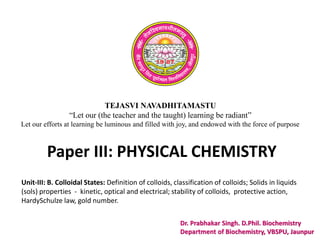
B.Sc. I Year Physical Chemistry_Unit III_Colloidal State Part 1
- 1. TEJASVI NAVADHITAMASTU “Let our (the teacher and the taught) learning be radiant” Let our efforts at learning be luminous and filled with joy, and endowed with the force of purpose Paper III: PHYSICAL CHEMISTRY Dr. Prabhakar Singh. D.Phil. Biochemistry Department of Biochemistry, VBSPU, Jaunpur Unit-III: B. Colloidal States: Definition of colloids, classification of colloids; Solids in liquids (sols) properties - kinetic, optical and electrical; stability of colloids, protective action, HardySchulze law, gold number.
- 2. Thomas Graham (1861) studied the ability of dissolved substances to diffuse into water across a permeable membrane. He observed that crystalline substances such as sugar, urea, and sodium chloride passed through the membrane, while others like glue, gelatin and gum arabic did not. The former he called crystalloids and the latter colloids(Greek, kolla= glue ; eidos= like). Graham thought that the difference in the behavior of ‘crystalloids’ and ‘colloids’ was due to the particle size. Later it was realized that any substance, regardless of its nature, could be converted into a colloid by subdividing it into particles of colloidal size. In a true solution as sugar or salt in water, the solute particles are dispersed in the solvent as single molecules or ions. Thus the diameter of the dispersed particles ranges from 1Å to 10 Å. On the other hand, in a suspension as sand stirred into water, the dispersed particles are aggregates of millions of molecules. The diameter of these particles is of the order 2,000 Å or more.
- 3. The colloidal solutions or colloidal dispersions are intermediate between true solutions and suspensions. In other words, the diameter of the dispersed particles in a colloidal dispersion is more than that of the solute particles in a true solution and smaller than that of a suspension. When the diameter of the particles of a substance dispersed in a solvent ranges from about 10Å to 2,000 Å, the system is termed a colloidal solution, colloidal dispersion, or simply a colloid. The material with particle size in the colloidal range is said to be in the colloidal state. The colloidal particles are not necessarily corpuscular in shape. In fact, these may be rod-like, disc-like, thin films, or long filaments. For matter in the form of corpuscles, the diameter gives a measure of the particle size. However, in other cases one of the dimensions (length, width and thickness) has to be in the colloidal range for the material to be classed as colloidal. Thus in a broader context we can say – “A system with at least one dimension (length, width, or thickness) of the dispersed particles in the range 10 Å to 2,000 Å, is classed as a colloidal dispersion”. COLLOIDS
- 6. SOLIDS IN LIQUIDS (SOLS)
- 7. CHARACTERISTICS OF LYOPHILIC AND LYOPHOBIC SOLS
- 10. KINETIC PROPERTIES OF SOLS
- 12. OPTICAL PROPERTIES OF SOLS
- 15. ELECTRICAL PROPERTIES OF SOLS
- 18. PROTECTIVE ACTION OF SOLS
- 21. Hardy-Schulze Rule When excess of an electrolyte is added to a sol, the dispersed particles are precipitated. The electrolyte furnishes both positive and negative ions in the medium. The sol particles adsorb the oppositely charged ions and get discharged. The electrically neutral particles then aggregate and settle down as precipitate A negative ion (anion) causes the precipitation of a positively charged sol, and vice versa. The effectiveness of an anion or cation to precipitate a sol, will naturally depend on the magnitude of the charge or valence of the effective ion. From a study of the precipitating action of various electrolytes on particular sol, Hardy and Schulze gave a general rule. “Hardy-Schulze Rule states that the precipitating effect of an ion on dispersed phase of opposite charge increases with the valence of the ion.”
- 23. GOLD NUMBER
